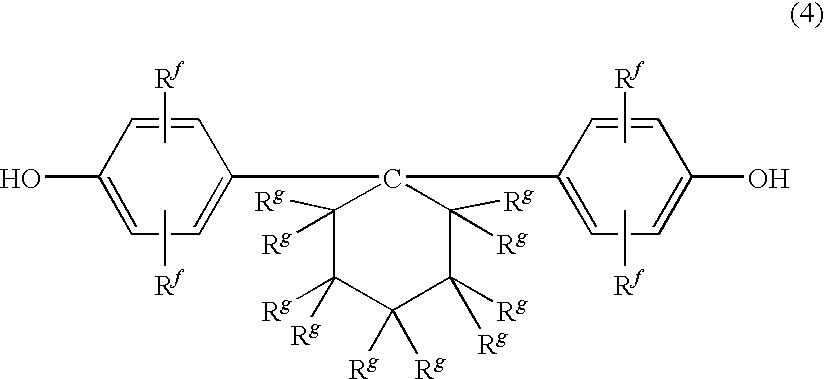Branched polycarbonate-polysiloxane copolymers and processes for producing the same
- Summary
- Abstract
- Description
- Claims
- Application Information
AI Technical Summary
Benefits of technology
Problems solved by technology
Method used
Image
Examples
example 1
[0079]A 75 L glass reactor was equipped with condenser, agitator, pH probe, caustic and phosgene inlets, and a recirculation loop. Methylene chloride (4-8 L), water (11 L), bisphenol-A (1900 grams, 8.33 moles), 4-cyanophenol (44 grams, 0.369 moles), a solution of 1,1,1-tris(hydroxyphenyl)ethane (92 grams, 0.300 moles) dissolved in NaOH (50% w / w, 75 grams, 0.245 moles) and water (750 mL), an aqueous solution of methyl tributylammonium chloride (70% w / w, 36 grams, 0.107 moles), and sodium gluconate (10 grams) were added to the reactor.
[0080]Phosgene and NaOH were co-fed to the reactor; the NaOH was provided to maintain the reactor pH. A total of 1270 grams phosgene (12.84 moles) was added during phosgenation. The phosgene and NaOH were co-fed to the reactor at a rate of 80 grams / minute with a target phosgene / NaOH molar ratio of 2.40 and a target pH of 6.
[0081]After phosgenation, the reactor pH was increased to pH 10 using NaOH and the presence of chloroformates was confirmed by checki...
example 2
[0085]A 75 L glass reactor was equipped with condenser, agitator, pH probe, caustic and phosgene inlets, and a recirculation loop. Methylene chloride (8 L), water (11 L), bisphenol-A (1900 grams, 8.33 moles), 4-cyanophenol (44 grams, 0.369 moles), a solution of 1,1,1-tris(hydroxyphenyl)ethane (92 grams, 0.300 moles) dissolved in NaOH (50% w / w, 75 grams, 0.245 moles) and water (750 mL), an aqueous solution of methyl tributylammonium chloride (70% w / w, 36 grams, 0.107 moles), and sodium gluconate (10 grams) were added to the reactor.
[0086]Phosgene and NaOH were co-fed to the reactor; the NaOH was provided to maintain the reactor pH. A total of 1270 grams phosgene (12.84 moles) was added during phosgenation. The phosgene and NaOH were co-fed to the reactor at a rate of 80 grams / minute with a target phosgene / NaOH molar ratio of 2.40 and a target pH of 6.
[0087]After phosgenation, the reactor pH was increased to pH 10 using NaOH and the presence of chloroformates was confirmed by checking...
example 3
[0091]A 75 L glass reactor was equipped with condenser, agitator, pH probe, caustic and phosgene inlets, and a recirculation loop. Methylene chloride (8 L), water (11 L), bisphenol-A (1900 grams, 8.33 moles), 4-cyanophenol (44 grams, 0.369 moles), a solution of 1,1,1-tris(hydroxyphenyl)ethane (154 grams, 0.503 moles) dissolved in NaOH (50% w / w, 125 grams, 0.245 moles) and water (750 mL), an aqueous solution of methyl tributylammonium chloride (70% w / w, 36 grams, 0.107 moles), and sodium gluconate (10 grams) were added to the reactor.
[0092]Phosgene and NaOH were co-fed to the reactor; the NaOH was provided to maintain the reactor pH. A total of 1270 grams phosgene (12.84 moles) was added during phosgenation. The phosgene and NaOH were co-fed to the reactor at a rate of 80 grams / minute with a target phosgene / NaOH molar ratio of 2.40 and a target pH of 6.
[0093]After phosgenation, the reactor pH was increased to pH 9 using NaOH and the presence of chloroformates was confirmed by checkin...
PUM
| Property | Measurement | Unit |
|---|---|---|
| Fraction | aaaaa | aaaaa |
| Melt viscosity | aaaaa | aaaaa |
| Transparency | aaaaa | aaaaa |
Abstract
Description
Claims
Application Information
 Login to View More
Login to View More - R&D
- Intellectual Property
- Life Sciences
- Materials
- Tech Scout
- Unparalleled Data Quality
- Higher Quality Content
- 60% Fewer Hallucinations
Browse by: Latest US Patents, China's latest patents, Technical Efficacy Thesaurus, Application Domain, Technology Topic, Popular Technical Reports.
© 2025 PatSnap. All rights reserved.Legal|Privacy policy|Modern Slavery Act Transparency Statement|Sitemap|About US| Contact US: help@patsnap.com



